Диспетчер учетных данных Windows (Credential Manager) позволяет безопасно хранить учетные записи и пароля для доступа к сетевым ресурсам, веб сайтам и приложениям. Благодаря сохраненным в Credential Manager паролям вы можете подключаться без ввода пароля к сетевым ресурсам, которые поддерживаются проверку подлинности Windows (NTLM или Kerbersos), аутентификацию по сертификату, или базовую проверку подлинности.
Содержание:
- Используем диспетчер учетных данных Windows для хранения паролей
- Управление сохраненными учетными данными Windows из командной строки
- Доступ к менеджеру учетных данных Windows из PowerShell
Используем диспетчер учетных данных Windows для хранения паролей
Диспетчер учетных данных встроен в Windows и позволяет безопасно хранить три типа учетных данных:
- Учетные данные Windows (Windows Credentials) — учетные данные доступа к ресурсам, которые поддерживаются Windows аутентификацию (NTLM или Kerbersos). Это могут быть данные для подключения сетевых дисков или общим SMB папкам, NAS устройствам, сохраненные пароли для RDP подключений, пароли к сайтам, поддерживающих проверку подлинности Windows и т.д;
- Учетные данные сертификатов (Certificate-Based Credentials) – используются для доступа к ресурсам с помощью сертификатов (из секции Personal в Certificate Manager);
- Общие учетные данные (Generic Credentials) – хранит учетные данные для доступа к сторонним приложениям, совместимым с Credential Manager и поддерживающим Basic аутентификацию;
- Учетные данные для интернета (Web Credentials) – сохранённые пароли в браузерах Edge и Internet Explorer, приложениях Microsoft (MS Office, Teams, Outlook, Skype и т.д).
Например, если при доступе к сетевой папке вы включите опцию “Сохранить пароль”, то введенный вами пароли будет сохранен в Credential Manager.
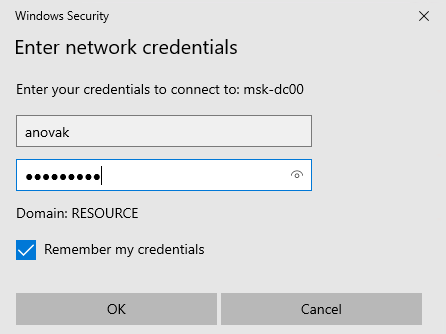
Аналогично пароль для подключения к удаленному RDP/RDS серверу сохраняется в клиенте Remote Desktop Connection (mstsc.exe).
Открыть диспетчер учетных данных в Windows можно:
- из классической панели управления (Control Panel\User Accounts\Credential Manager, Панель управления -> Учетные записи пользователей -> Диспетчер учетных данных);
- изкоманднойстроки:
control /name Microsoft.CredentialManager
На скриншоте видно, что в Credential Manager хранятся два пароля, которые мы сохранили ранее.
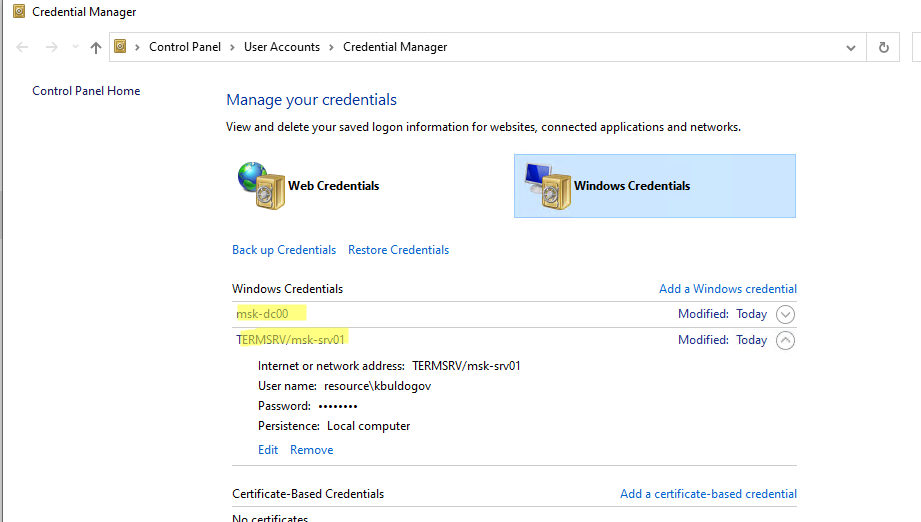
Сохраненный пароль для RDP подключения сохраняется в формате
TERMSRV\hostname
.
Здесь вы можете добавить сохранённый пароль, отредактировать (просмотреть сохраненный пароль в открытом виде из графического интерфейса нельзя) или удалить любую из записей.
Для управления сохраненными паролями можно использовать классический диалоговый интерфейс Stored User Names and Password. Для его запуска выполните команду:
rundll32.exe keymgr.dll,KRShowKeyMgr
Здесь вы также можете управлять сохраненными учетными данными, а также выполнить резервное копирование и восстановление записей в Credential Manager (можно использовать для переноса базы Credential Manager на другой компьютер).
Управление сохраненными учетными данными Windows из командной строки
Вы можете добавить удалить и вывести сохраненные учетные данных в Credentil Manager из командной строки с помощью утилиты cmdkey.
Добавить в диспетчер учетные данные для доступа к серверу FS01:
cmdkey /add:FS01 /user:kbuldogov /pass:Passw0rdd1
Если нужно сохранить доменную учетную запись:
cmdkey /add:fs01.winitpro.local /user:[email protected] /pass:Passw0rdd1
Сохранить учетные данные для доступа к RDP/RDS серверу:
cmdkey /generic:termsrv/MSKRDS1 /user:kbuldogov /pass:Passw0rdd1
Вывести список сохраненных учетных данных:
cmdkey /list
Вывести список хранимых учетных данных для указанного компьютера:
cmdkey /list:fs01.winitpro.local
Удалить ранее сохраненные учетные данные:
cmdkey /delete:FS01
Удалить из Credential Manager все сохраненные пароли для RDP доступа:
For /F "tokens=1,2 delims= " %G in ('cmdkey /list ^| findstr "target=TERMSRV"') do cmdkey /delete %H
Полностью очистить пароли в Credential Manager:
for /F "tokens=1,2 delims= " %G in ('cmdkey /list ^| findstr Target') do cmdkey /delete %H

Также для управления сохраненными учетными данными можно использовать утилиту vaultcmd.Вывести список сохраненных учетных данных типа Windows Credentials:
vaultcmd /listcreds:"Windows Credentials"
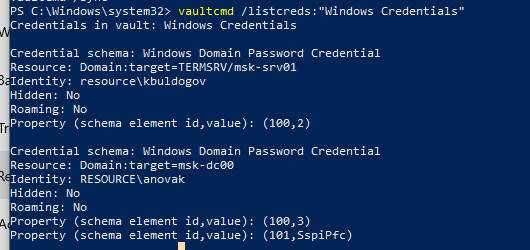
Все сохраненные пароли хранятся в защищенном хранилище Windows Vault. Путь к хранилищу можно получить с помощью команды:
vaultcmd /list

По умолчанию это
%userprofile%\AppData\Local\Microsoft\Vault
. Ключ шифрования хранится в файле Policy.vpol. Клю шифровани используется для рашировки паролей в файлах .vcrd.
Для работы Credential Manager должна быть запущена служба VaultSvc:
Get-Service VaultSvc
Если служба отключена, при попытке получить доступ к Credential Manager появится ошибка:
Credential Manager Error The Credential Manager Service is not running. You can start the service manually using the Services snap-in or restart your computer to start the service. Error code: 0x800706B5 Error Message: The interface is unknown.
Если вы хотите заблокировать пользователям возможность сохранения сетевых паролей в Credential Manager, нужно включить параметр Network access: Do not allow storage of passwords and credentials for network authentication в разделе GPO Computer Configuration -> Windows Settings -> Security Settings -> Local Policies -> Security Options.
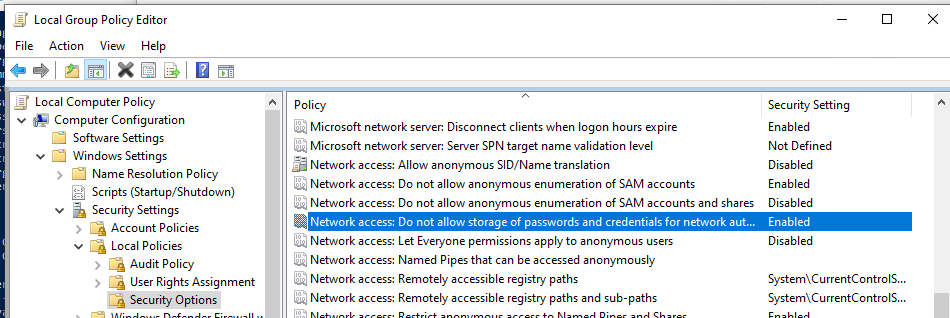
Теперь, если пользователь попытается сохранить пароль в хранилище, появится ошибка:
Credential Manager Error Unable to save credentials. To save credentials in this vault, check your computer configuration. Error code: 0x80070520 Error Message: A specified logon session does not exist. It may already have been terminated.
Доступ к менеджеру учетных данных Windows из PowerShell
В Windows нет встроенных командлетов для обращения к хранилищу PasswordVault из PowerShell. Но вы можете использовать модуль CredentialManager из галереи PowerShell.
Установите модуль:
Install-Module CredentialManager

В модуле всего 4 командлета:
- Get-StoredCredential – получить учетные данные из хранилища Windows Vault;
- Get-StrongPassword – сгенерировать случайный пароль;
- New-StoredCredential – добавить учетные данные в хранилище;
- Remove-StoredCredential – удалить учетные данные.
Чтобы добавить новые учетные данные в хранилище CredentialManager, выполните команду:
New-StoredCredential -Target 'contoso' -Type Generic -UserName '[email protected]' -Password '123qwe' -Persist 'LocalMachine'

Проверить, есть в хранилище сохраненные данные:
Get-StoredCredential -Target contoso
С помощью командлета Get-StoredCredential вы можете вывести сохраненный пароль, хранящийся в диспетчере учетных данных в отрытом виде.
Выведите список сохраненных учетных данных:
cmdkey.exe /list
Скопируйте значение Target для объекта, пароль которого вы хотите извлечь и вставьте его в следующую команду:
$cred = Get-StoredCredential -Target LegacyGeneric:target=termsrv/MSKRD2S1 [System.Runtime.InteropServices.Marshal]::PtrToStringAuto([System.Runtime.InteropServices.Marshal]::SecureStringToBSTR($cred.Password))
Команда выведет сохраненный пароль в открытом виде.
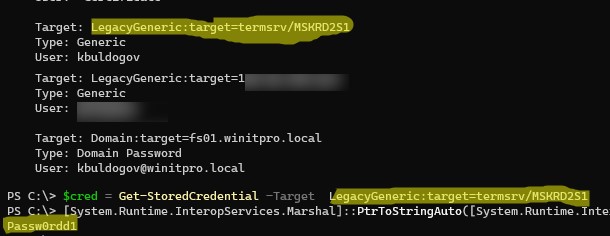
Также для получения сохраненных паролей из credman в открытом виде можно использовать утилиты типа Mimikatz (смотри пример).
Сохраненные пароли из Credential Manager можно использовать в ваших скриптах PowerShell. Например, в следующем примере я получаю сохраненные имя и пароль в виде объекта PSCredential и подключаюсь с ними к Exchange Online из PowerShell:
$psCred = Get-StoredCredential -Target "Contoso"
Connect-MSolService -Credential $psCred
Также вы можете использовать Get-StoredCredential для безопасного получения сохранённых учетных данных в заданиях планировщика.
Также обратите внимание на модуль PowerShell Secret Management, который можно использовать для безопасного хранения паролей в Windows (поддерживает различные хранилища паролей: KeePass, LastPass, HashiCorp Vault, Azure Key Vault, Bitwarden.
Чтобы удалить сохраненные учетные данные из Windows Vault, выполните:
Remove-StoredCredential -Target Contoso
Updated by
Cici on Jan 23, 2025
What should you do when you forget your Windows 11 password? Don’t worry. If you have allowed Windows to save your passwords, then in this guide, we will explore where passwords are stored in Windows 11. We will also dive deep into how to view saved password in Windows 11 in multiple ways. EaseUS covered you all with our answers!
Where Are Passwords Stored in Windows 11?
Within the Windows operating system, the application known as the Credentials Manager assumes responsibility for safeguarding your login information and passwords. Typically, this data is securely encrypted. Authentication of your identity becomes necessary to retrieve passwords associated with specific websites. To accomplish this, you will be prompted to provide the Administrator password. It is important to note that this particular application does not support altering passwords for existing user accounts.
Now that you know where the passwords are saved, let’s, check each of the details to figure out where they are stored. If you like this tutorial to find your password, you can also click the buttons and share it with others in need.
Many applications like the Credential Manager, the Windows registry/vault, and the Command Prompt save passwords in Windows 11. Let’s look at each of them!
| Solutions | Effectiveness | Difficulty |
|---|---|---|
| Use Key Finder to View Saved Passwords Windows 11 | 👍High— It provides a quick and easy way to help you quickly find all the passwords stored on Windows. | ⭐ |
| Use Credential Manager to View Saved Passwords Windows 11 | 👍High— Anyone with administrative privileges can access the credential manager and view passwords. | ⭐⭐ |
| Use CMD to View Saved Passwords Windows 11 | Medium— This program requires users to be proficient at the command line. It is prone to misuse. | ⭐⭐⭐ |
| Use Registry Editor to View Saved Passwords Windows 11 | Medium— It is a database provided by Windows. Messing with it can potentially damage the system. | ⭐⭐⭐ |
Let’s dig into the details!
How to Find Windows Login Password
Discover quick steps to retrieve or reset your Windows login password. Here’s how to find Windows login passwords ensuring secure and easy access to your system.
Way 1. Using EaseUS Key Finder to View Saved Passwords Windows 11
EaseUS Key Finder is a utility software that helps you find activation keys, ProductIDs, CD-Keys of Adobe, Microsoft, etc, along with WiFi codes and passwords. This is a beginner-friendly tool for your problem of recovering passwords. Download it on your system and follow the steps to regain your passwords.
Step 1. Launch EaseUS Key Finder, and click «Windows Credentials» on the left pane.
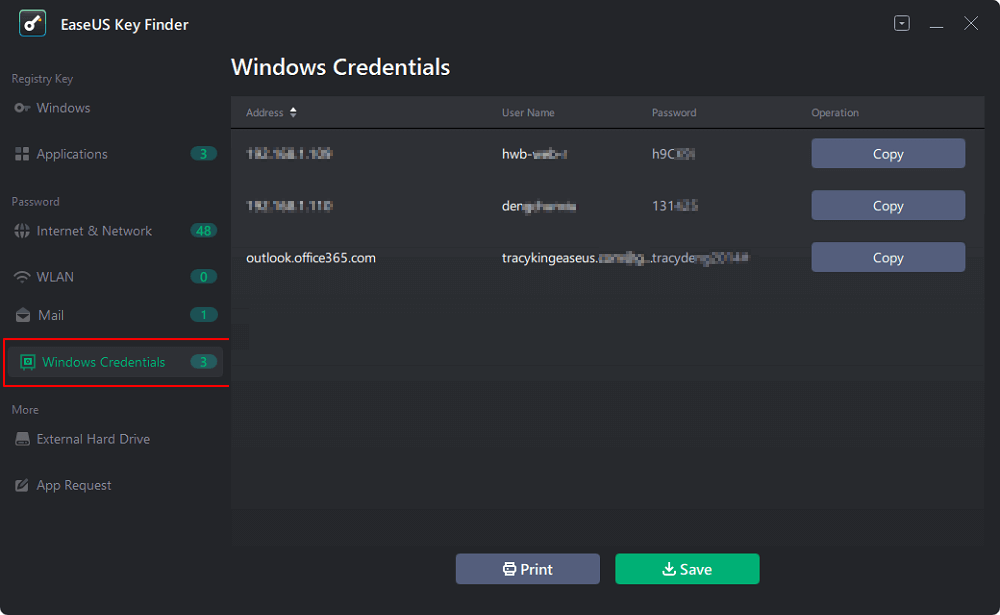
Step 2. Now, you can check all available Windows Credential addresses with respective user names, and passwords.
You can click «Copy», «Print», or «Save» these Windows Credentials’ accounts and passwords at one time.
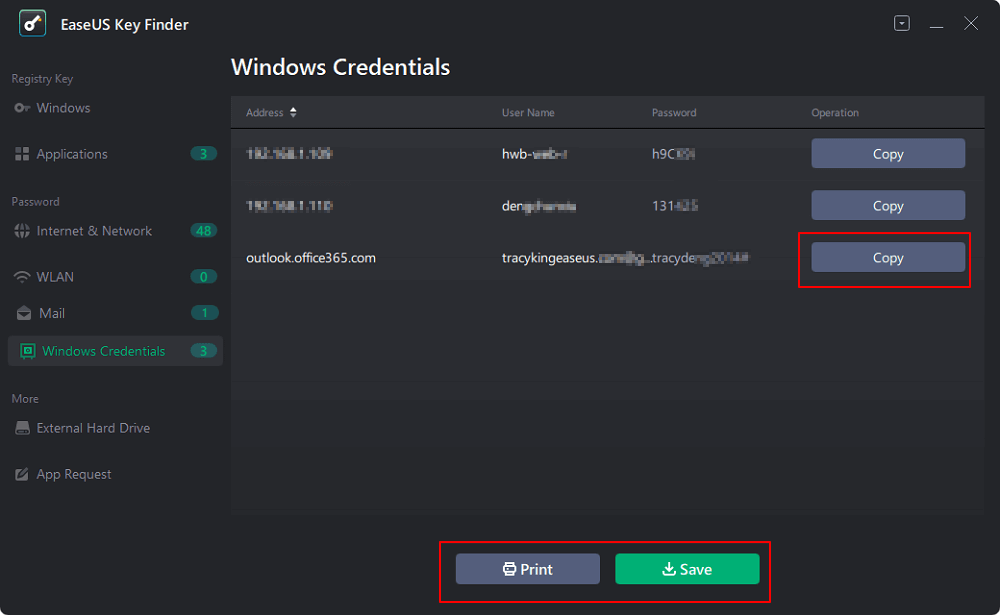
EaseUS Key Finder manages passwords and can help recover lost product keys, WiFi passwords, and find product keys from a dead PC. It is the ultimate solution for your password problems! Download it by clicking on the button below.
Way 2. Using Credential Manager to View Saved Passwords Windows 11
Credential Manager is an integral part of Windows that stores web usernames, passwords, and other Windows Credentials. While you may be using a browser to save the password, what happens in the background is stored in it.
The good thing is that anyone with admin permissions can access the Credential Manager and view the password.
Step1. Go to the search bar of the Windows Start button.
Step 2. Type Credential Manager in the search bar on the top.
Step 3. Click Open, and it should open a new window. You can see two options – the Web Credentials and the Windows Credentials.
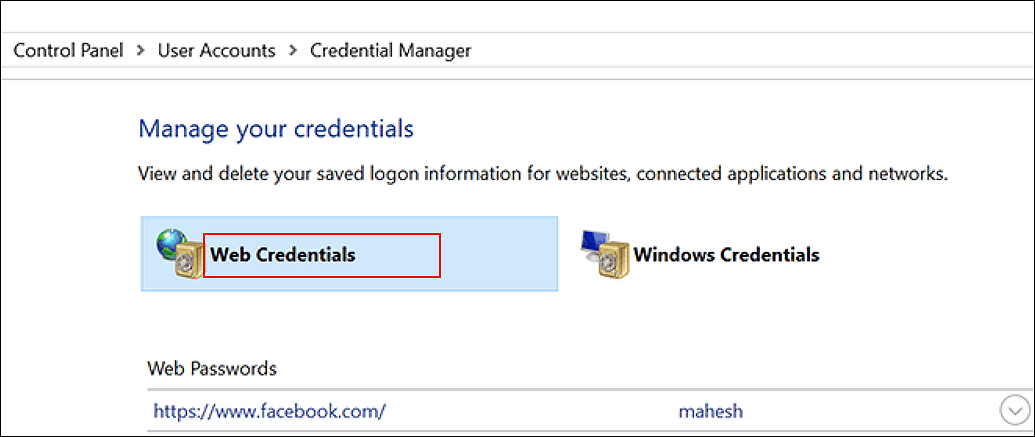
Web Credentials keep sensitive information about your website logins. Besides, Windows Credentials have the logins for the PC.
Step 1. Look for the login from the list in either of them and when you find it, click on the little arrow on the right.
Step 2. In the drop-down tab, click Edit below the password.
Step 3. Edit the password in the pop-up. And that’s it!
And that’s it! You have successfully accessed Credentials Manager and edited your forgotten passwords. However, as mentioned earlier, this isn’t the only way to access your PC passwords, so stay with us as we discover the following method!
Way 3. Using Command Prompt to View Saved Passwords Windows 11
Many things in Windows can be achieved through Command Prompt or Windows Terminal. Some tools don’t have UI but can run from the terminal with options and parameters.
Regarding Password access, the command prompt helps you access the keyword manager. Here is how you can do it.
Step 1. Go to Windows Start and type Command Prompt in the search bar.
Sep 2. Click on Run as Administrator on the right-hand side.
Step 3. A prompt asks you if you wish to let this app make changes to your system. Click on Yes.
Step 4. The Command Prompt appears as a black screen with few lines of text. Do not worry; we are here to guide you.
Step 5. In the active Command Prompt Window, type this command – rundll32.exe keymgr.dll,KRShowKeyMgr and press the Enter key.
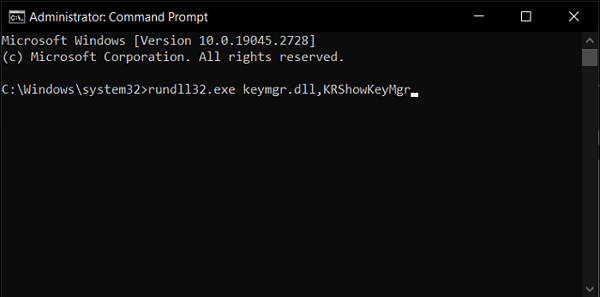
The Stored User Names and Passwords window will show up. With this way, you can successfully find computer username and password. And you can now Add, Remove, or Edit existing passwords, but you would still need the Administrator Password to perform those tasks here.
We will now guide you through the steps to recover the master password. However, you must be careful since one wrong step might lead to OS failure.
Way 4. Registry Editor to View Saved Passwords Windows 11
Windows Registry Editor is a database of Windows where OS and other software can save settings and data to access it anytime. However, there is no way to get a password from the registry. The methods available on other websites are for Automatically login to PC and not revealing passwords. I would suggest adding it as another bonus. I have given the steps below:
You can access the registry files using some in-built commands using the Command Prompt. This method is beneficial when you want to access the Admin password.
Step 1. Run Command Prompt as an Administrator.
Step 2. Type the command «regedit» and press Enter.
Step 3. The Registry Editor window appears.
Step 4. Now, navigate to HKEY_ LOCAL_MACHINE > SOFTWARE > Microsoft > Windows NT > CurrentVersion > Winlogon.
Step 5. Find «DefaultPassword» and double-click it.
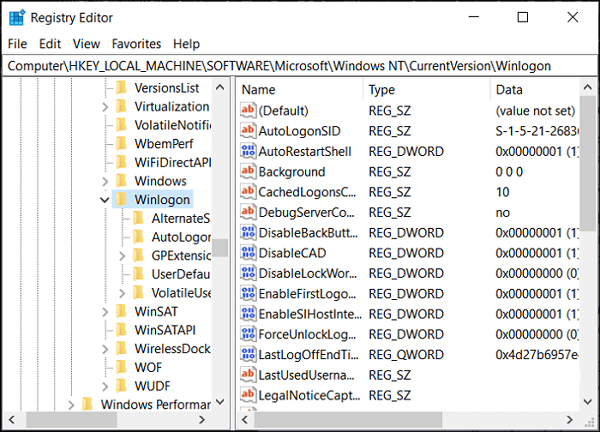
Step 6. A window opens, revealing the original password.
The registry is an integral part of the OS; messing it up can harm your system. Make sure you follow the above steps carefully with attention to the desired results.
Bonus Tip: How to View Saved WiFi Passwords in Windows 11?
Windows saves passwords for WiFi into the adapter information, and they can be easily accessed using the interface.
If you struggle to remember your WiFi password, which you installed years ago, we get it. We have been there too. So let’s jump right into the steps to check your saved WiFi passwords on your Windows 11 system!
Three methods can achieve the goal: you can use Windows built-in tools or a professional third-party tool — EaseUS Key Finder. With the help of this professional tool, you can quickly check your WiFi password in just a few simple steps.
Step 1. Launch EaseUS Key Finder on your laptop, click «WLAN» on the left pane.
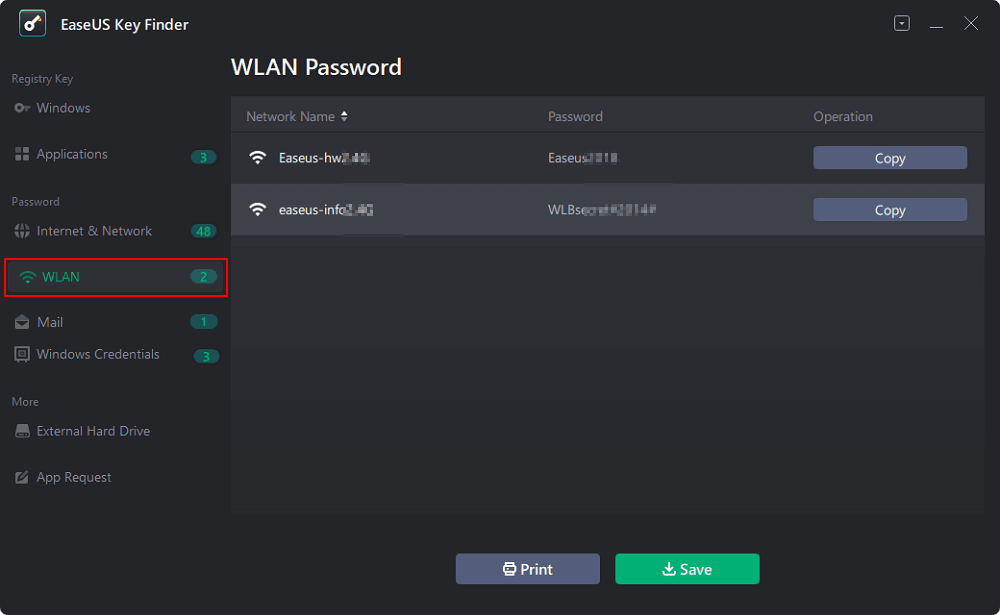
Step 2. Find your WiFi account, and you’ll see the password next to your network name.
You can directly click «Copy» to copy the WiFi password and join in your wireless network immediately.
Or, you can also, click «Print» or «Save» to back up all your WiFi networks and passwords.
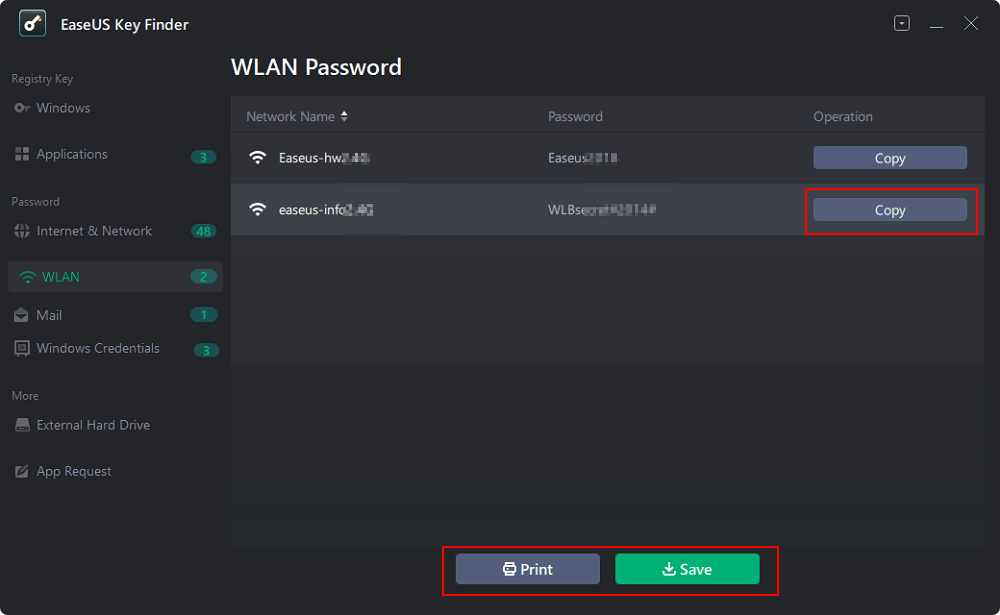
If you wish to see the saved passwords of previous networks, you can use the command prompt for the same. For more details, you can visit the link below:
How to See Wifi Password Windows 11
Windows 11 has three straightforward options to see your WiFi password. If you forgot your password, you could follow the below-mentioned methods to check your WiFi password quickly.
Conclusion
Passwords are the most integral part of your system’s security. In today’s era of data breaches and identity thefts, keeping your security at its best is paramount. In this article, we delved into ways to explore how we can retrieve and edit passwords on your system in several different ways. It included EaseUS Key Finder, using the Credential Manager, and the Command Prompt.
If you are a tech genius and love to play around, using the Credential Manager method is best recommended. This way, you also save yourself from spending a few bucks buying a coffee. However, if tech and computers aren’t your things, EaseUS Key Provider seems to be the best fit for your cause of its beginner-friendly attributes and the extensive features of the product.
FAQs About How to View Saved Password in Windows 11
You would have specific queries about Windows 11 passwords stored. And we have aimed to answer the most asked ones!
1. Where are admin passwords saved in Windows 10?
Admin passwords that allow the admin to log in to the account automatically can be seen through the registry. However, it can only be seen by the admin and no one else.
2. How to save passwords on Windows 11?
The best recommendation would be to use a personal password manager, which stores everything in one place. They are easy to install and work like a charm.
3. How to find saved WiFi passwords in Windows 11?
Saved WiFi passwords can be found by accessing the Control Panel and then going to the Network and Sharing Centre. It can also be done using the Comma nd Prompt or a third-party app like EaseUS Key Finder.
Бывает, нужно зайти в старый почтовый аккаунт, соцсеть или другой сервис, а пароль вспомнить не получается — приходится проходить процедуру восстановления или регистрироваться по новой. Но, если вы раньше входили на сайт со своего устройства, данные, скорее всего, сохранились. В системных настройках или в браузере можно посмотреть, изменить или удалить пароль — например, если гаджетом пользуются несколько человек.
Чтобы не допустить утечки паролей и других личных данных, используйте антивирус. Например, в Kaspersky Plus есть встроенная защита паролей и конфиденциальной информации: если система заподозрит, что данные раскрыли, то предложит их изменить.
Рассказываем, как найти сохраненные пароли на смартфонах Android и iOS, а еще в браузерах на Windows и macOS.
Как найти пароли на iPhone
В системе iOS хранятся пароли от всех сайтов и приложений, на которые вы заходили с устройства. Чтобы найти сохраненные данные, зайдите в «Настройки» и найдите вкладку «Пароли». Для входа введите код-пароль от устройства или подтвердите личность с помощью Face ID.
Во вкладке появится список сайтов, для которых сохранены пароли. Чтобы посмотреть сам пароль, нажмите на нужный сайт или выберите сверху опцию «Править».
В той же вкладке есть советы по смене пароля. Зайдите в «Рекомендации по безопасности» и посмотрите, какие пароли система предлагает изменить — например, потому что они слишком легкие.
В разделе «Настройки» выберите «Пароли», а затем коснитесь нужного сайта или нажмите «Править»
Нажмите «Удалить пароль», если хотите полностью стереть данные. Чтобы изменить пароль, выберите «Изменить пароль на веб-сайте» — система автоматически переведет вас на сайт, чтобы отредактировать данные.
Удалить пароль можно в меню настроек, а чтобы его изменить, перейдите на сайт
Есть и другой способ: забытый пароль можно узнать у Siri. Для этого скажите, например: «Привет, Siri. Покажи мои пароли». Система сама откроет вам нужную вкладку.
На смартфонах Android
В системных настройках смартфона хранятся пароли от приложений и браузера Chrome. Чтобы их посмотреть, зайдите в «Настройки» → Google → «Управление аккаунтом Google».
Пролистайте вниз меню «Настройки», выберите Google и зайдите в «Управление аккаунтом Google» — вкладка находится под именем и адресом электронной почты
В открывшемся меню пролистайте вправо от пункта «Главная» к разделу «Безопасность» и нажмите на него. Затем прокрутите страницу вниз до конца и зайдите в «Менеджер паролей». После того как нажмете на нужный сайт, система попросит вас ввести пароль или разблокировать устройство отпечатком пальца.
Выберите вкладку «Безопасность» и перейдите в «Менеджер паролей»
Чтобы посмотреть пароль, нажмите на иконку в форме глаза. Если нужно его отредактировать, нажмите «Изменить» — так вы поменяете запись в системе, но на сайте пароль останется таким же. Опция пригодится, если посещали ресурс с чужого устройства и поменяли пароль: в этом случае в хранилище его придется записать отдельно.
Однако, если вы просто отредактируете данные в системе, сам пароль от аккаунта останется прежним и зайти на сайт с новыми данными из хранилища уже не получится.
В Android можно проверить, насколько защищены ваши личные данные. Для этого нажмите на кнопку «Проверка паролей». Если обнаружится, что ваш пароль есть в базах данных украденных логинов, или найдутся слишком простые комбинации, система предложит их заменить.
Кроме этого, менеджер паролей от Google подсвечивает учетные записи, в которых вы используете одинаковые пароли — в этом случае их лучше поменять.
Можно посмотреть или изменить пароль прямо в системных настройках, а если переживаете, что пароль «слили» в Сеть, зайдите в меню «Проверка паролей»
Как узнать пароли в сторонних браузерах на Android и iOS
Сторонние браузеры на Android не синхронизируются с системой и хранят данные только в своем менеджере паролей. Например, если заходите в кошелек ЮMoney через Яндекс Браузер, пароль сможете найти только там.
В устройствах iOS все пароли сохраняются в системных настройках. В каком бы браузере вы ни работали, данные попадут в папку «Пароли» — только там можно их просмотреть, изменить или удалить. Однако некоторым удобнее искать пароли прямо в браузере, а смотреть или править уже в системном меню — рассказываем, как это сделать на устройствах iOS и Android.
Google Chrome. Нажмите на три вертикальные точки сверху или снизу окна и зайдите в меню браузера → «Настройки» → «Менеджер паролей».
На устройствах Android путь такой же, как в системных настройках: кликните по нужному сайту → подтвердите личность с помощью пароль или сканера отпечатков → нажмите на иконку в форме глаза, чтобы посмотреть пароль. Если нужно его отредактировать, выберите кнопку «Изменить», а если хотите стереть пароль совсем — нажмите «Удалить».
Устройства iOS автоматически перенаправят в «Настройки», где вы сможете посмотреть, изменить или удалить пароль из хранилища.
Нажмите на три точки, зайдите в «Настройки» и выберите «Менеджер паролей»
Яндекс Браузер. Зайдите в меню профиля и нажмите на кнопку «Пароли» — внутри появится список сайтов с сохраненными данными.
Вкладку «Пароли» можно найти через меню профиля — оно выглядит как кружок с силуэтом человека. Если залогинитесь, в кружке появится фотография профиля или инициалы
Чтобы посмотреть данные, разблокируйте устройство с помощью код-пароля, Face ID или отпечатка пальца. Откроется меню с названием сайта, логином и паролем. Чтобы их изменить, нажмите на три точки в верхнем правом углу и выберите «Редактировать» или «Удалить». Еще изменить запись в хранилище можно, нажав на карандаш на строке ввода логина или пароля — он находится справа от поля ввода.
Чтобы изменить пароль в хранилище iOS, придется перейти в системные настройки.
Выберите нужный сайт и нажмите на карандаш или три точки в правом верхнем углу, чтобы изменить или удалить пароль
Mozilla Firefox. Чтобы узнать пароль на устройствах Android, перейдите в меню браузера → «Настройки» → «Пароли».
Нажмите на меню браузера, перейдите в «Настройки» и выберите «Пароли»
Выберите вкладку «Сохраненные пароли» и разблокируйте устройство паролем или отпечатком пальца — в окне появится список со всеми сайтами, пароли от которых сохранены в браузере.
Кликните по нужному сайту, а затем по иконке глаза, чтобы посмотреть сохраненный пароль. Чтобы его отредактировать, нажмите на три точки в правом верхнем углу и выберите «Править» или «Удалить».
Зайдите в «Сохраненные пароли» — появится меню, в котором можно посмотреть, изменить или удалить данные
В устройствах iOS зайдите в меню браузера и откройте вкладку «Пароли». Чтобы увидеть список сайтов с сохраненными паролями, разблокируйте устройство с помощью Face ID или код-пароля. Затем нажмите на нужный сайт: система направит вас в настройки, чтобы посмотреть, удалить или изменить пароль в хранилище.
Нажмите на три полоски, зайдите в меню браузера и выберите вкладку «Пароли»
Microsoft Edge. Для смартфонов iOS и Android алгоритм одинаковый. Сначала зайдите в меню браузера и выберите «Параметры».
Нажмите на три полоски и выберите в меню вкладку «Параметры»
Перейдите во вкладку «Учетные записи» и нажмите «Пароли». Затем пролистайте вниз, чтобы посмотреть список сайтов, и выберите нужный. Далее нажмите на строчку с логином и сайтом, чтобы посмотреть или отредактировать пароль.
Нажмите на «Учетные записи», а затем перейдите во вкладку «Пароли», чтобы увидеть список сайтов с сохраненными данными
На смартфонах Android откроется окно, в котором можно ввести новый пароль или посмотреть старый — для этого нажмите на иконку глаза. Чтобы удалить его, кликните по мусорной корзине в правом верхнем углу.
После того как введете новый пароль, нажмите «Готово» — данные сохранятся
Safari стоит во всех устройствах iOS по умолчанию, но посмотреть в нем данные не получится, так как у него нет встроенного менеджера паролей. Все личные данные сохраняются сразу в систему. Чтобы посмотреть или изменить их, зайдите в «Настройки» → «Пароли».
Как найти пароли в браузере на компьютере
В операционной системе Windows сохраненные пароли можно найти в браузере, а в macOS — в браузере и системных настройках.
Google Chrome. Нажмите на значок вашего профиля, а затем на иконку с изображением ключа — откроется «Менеджер паролей».
Нажмите на кружок в верхнем правом углу, а затем — на иконку в виде ключа
Все сайты в «Менеджере паролей» расположены в алфавитном порядке. Чтобы найти нужный, вбейте название сайта в строку поиска.
Кликните на сайт, от аккаунта на котором забыли пароль
В открывшемся меню можно посмотреть, изменить или удалить пароль. На macOS система может потребовать подтверждение личности, на Windows дополнительно ничего вводить не нужно.
Нажмите на иконку глаза, чтобы посмотреть пароль. Еще внизу есть кнопки «Изменить» и «Удалить»
Яндекс Браузер. Нажмите на значок с ключом — откроется вкладка «Пароли».
Нажмите на значок с ключом, который находится справа от строки поиска
Внутри сайты расположены в алфавитном порядке. Выберите нужный, чтобы посмотреть, изменить или удалить пароль.
Кликните на строку с сайтом
Далее откроется меню, где вы сможете посмотреть, удалить или отредактировать данные. На macOS система может потребовать ввести дополнительный пароль, на Windows дополнительно ничего подтверждать не нужно.
Узнайте старый пароль или введите новый
Mozilla Firefox. Зайдите в меню браузера и перейдите во вкладку «Пароли».
Чтобы открыть вкладку «Пароли», нажмите на три полоски в правом верхнем углу
Далее откроется страница, на которой в колонке слева будет список сайтов, а в большом окне — меню, в нем можно посмотреть, изменить или удалить пароль. Выберите в колонке нужный сайт и отредактируйте данные. На macOS система может потребовать ввести дополнительный пароль, на Windows дополнительно ничего подтверждать не нужно.
Чтобы посмотреть пароль, нажмите на иконку глаза рядом с ним
Microsoft Edge. Зайдите в меню браузера и откройте «Параметры».
Нажмите на три точки в правом верхнем углу, а затем — на «Параметры»
В открывшемся меню выберите вкладку «Пароли» — появится информация о сайтах, на которые вы заходили через браузер.
Откройте вкладку «Пароли»
Пролистайте страницу вниз, чтобы найти список сайтов. Выберите нужный, а затем нажмите на иконку глаза, чтобы посмотреть пароль. Здесь же можно удалить или изменить данные — для этого нажмите на три точки и выберите нужное действие.
Нажмите на три точки в строке пароля, чтобы скопировать, изменить или удалить пароль. А чтобы посмотреть — на иконку глаза
Safari. В этом браузере нет встроенного менеджера паролей, поэтому сохраненные данные с сайтов можно посмотреть через меню «Системные настройки». Для этого зайдите в меню Apple и нажмите «Системные настройки».
Нажмите на яблоко — так в устройствах macOS выглядит меню Apple
В колонке слева выберите вкладку «Пароли». Данные будут скрыты — чтобы увидеть их, введите пароль от устройства или подтвердите вход с помощью Apple Watch.
Введите пароль от аккаунта или подтвердите вход с помощью Apple Watch, чтобы получить доступ к паролям
Выберите из списка нужный сайт: чтобы искать быстрее, введите название в строку поиска, которая находится сверху.
Нажмите на нужный сайт
На экране появится меню пароля: чтобы редактировать или удалить данные, нажмите на кнопку «Изменить».
Можно изменить пароль прямо на сайте — для этого нажмите «Изменить пароль на веб-сайте»
А еще пароли можно спросить у Siri. Для этого просто скажите: «Siri, покажи мои пароли». Система автоматически откроет нужную вкладку.
Кратко: как найти сохраненные пароли
- На устройствах iOS все пароли сохраняются в системных настройках независимо от того, где их вводят: например, в Safari, Mozilla Firefox или приложении. Еще пароли можно спросить у Siri или посмотреть в браузере, но изменить или удалить только в настройках.
- Система Android хранит данные только от приложений или браузера Chrome. Например, если зайдете на сайт через Яндекс Браузер, пароль придется искать там. Посмотреть и отредактировать данные можно через настройки или браузер в зависимости от того, где сохранился пароль.
- В Windows пароли можно посмотреть или отредактировать в браузерах: дополнительно подтверждать вход для этого не придется.
- На macOS вся информация есть в настройках системы, но чтобы посмотреть сохраненные данные, придется ввести пароль от аккаунта.
How do I find saved passwords in Windows 10? A large number of programs and websites usually prompt its users’ to save their passwords for later use in their PCs and mobile phones. This gets usually stored on software like Instant Messenger, Windows Live Messengers and popular browsers like Google Chrome, Internet Explorer, Microsoft Edge, Mozilla Firefox, Opera (for both PCs and smart-phones) also provide this password saving feature. This password is usually stored in the secondary memory and can be retrieved even when the system is turned off. Specifically, these usernames, as well as their associated passwords, get stored in the registry, within the Windows Vault or within credential files. All such credentials get accumulated in an encrypted format, but can easily be decrypted just by entering your Windows password.
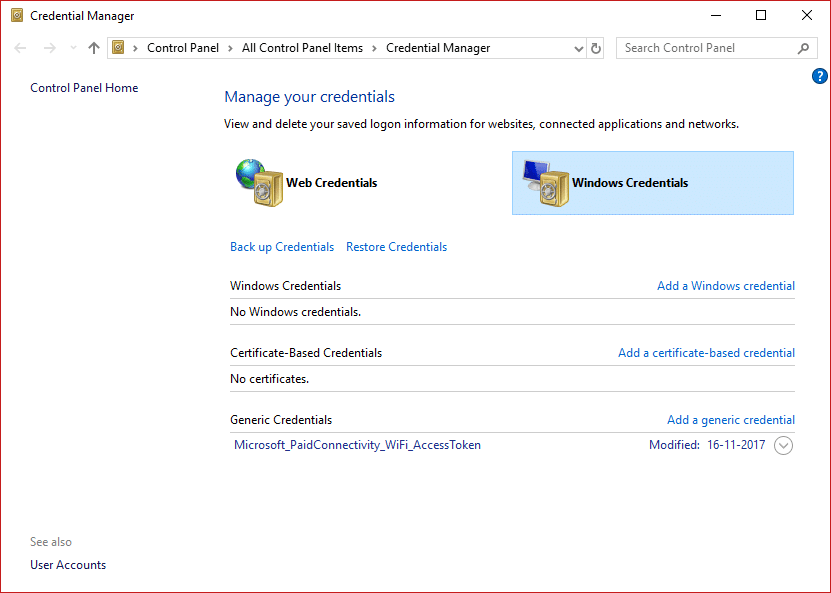
A frequent task that comes into play for all end-users is to uncover all the stored passwords on his/her computer. This eventually helps in recovering lost or forgotten access details to any specific online service or application. This is an easy task but depends on some of the aspects like the OS that the user is using or the application someone is using. In this article, we will show you different tools that can help you view different hidden encrypted passwords in your system.
Table of Contents
Method 1: Using Windows Credential Manager
Let us first get to know about this tool. It is a built-in Credential Manager of Windows that allows users to store their confidential username and passwords as well as other credentials that are entered in when a user logs on to any website or network. Storing these credentials in a manageable manner can help you automatically log you on to that site. This eventually reduces the time and effort of a user as they don’t have to type their login credentials every time they use this site. To see these usernames and passwords stored in the Windows Credential Manager, you have to go through the following steps –
1. Search for “Credential Manager” in the Start menu search box. Click on the search result to open.
Note: You’ll notice there are 2 categories: Web Credentials & Windows Credentials. Here your entire web credentials, as well as any passwords from sites which you saved during browsing using different browsers will be listed here.
2. Choose and Expand the link to see the password by clicking on the arrow button under the Web Passwords option and click on the “Show” button.

3. It will now prompt you to type your Windows password for decrypting the password and show it to you.
4. Again, when you click on Windows Credentials next to the Web Credentials, you will most likely see lesser credentials stored there unless you’re into a corporate environment. These are application and network-level credentials as and when you connect to network shares or network devices like the NAS.

Recommended: Reveal Hidden Passwords behind asterisk without any software
Method 2: Find Saved Passwords using Command Prompt
1. Press Windows Key + S to bring up search. Type cmd then right-click on Command Prompt and select Run as Administrator.
2. Now type the following command into cmd and hit Enter:
rundll32.exe keymgr.dll,KRShowKeyMgr
3. Once you hit Enter, stored Usernames and Passwords window will open.

4. You can now add, remove or edit the stored passwords.
Method 3: Using third-party tools
There are other 3rd party tools available that will help you view your passwords stored in your system. These are:
a) CredentialsFileView
1. Once downloaded, right-click on the “CredentialsFileView” application and choose Run as Administrator.
2. You will see the main dialog which will pop up. You will have to type in your Windows password at the bottom side and then press “OK”.
Note: Now it will be possible for you to see the list of different credentials stored on your computer. If you are on a domain, you will also see a lot more data in the form of a database having Filename, version modified time etc.

b) VaultPasswordView
This has the same functionality as that of CredentialsFileView, but it will look inside the Windows Vault. This tool is essential particularly for Windows 8 & Windows 10 users as these 2 OS stores the passwords of different apps like Windows Mail, IE, and MS. Edge, in the Windows Vault.

c) EncryptedRegView
1. Run this program, a new dialog box will pop up where the ‘Run as administrator’ box will be checked, press the “OK” button.
2. The tool will automatically scan the registry & decrypt your existing passwords it will fetch from the registry.

Also read: How to Create a Password Reset Disk
Using any of the three methods you will be able to view or find the saved passwords on Windows 10, but if you still have questions or doubts regarding this tutorial then feel free to ask them in the comment section.
“I’ve been looking everywhere for my saved passwords on my windows 10 PC. My PC seem to have a problem accepting my new passwords after I changed them. When I do manage to find my way to credential manager and manage passwords, it demands ID verification with a username and password, which I can’t even remember having set up in the first place. I could really use some help with this issue, before I end up in the nut house!” From Microsoft Community
There are some users have this problem. For this reason, we collated some of the most useful information and hence, have tailored this post specifically to make users understand where are passwords stored in windows 10/11 and how to find passwords on windows 10/11! So stay glued to the article and you’ll get the answers yourself.
- Part 1: Where Are Windows Passwords Stored
- Part 2: How to Reset Windows 10/11 Administrator Password
Basically, all your password or credentials are stored in Credentials Manager application of Windows 10. They are generally store in an encrypted form. Now, if in case, you require to view the saved passwords of websites, you surely can do that but it will require your identity verification. You’ll be asked to put in the Administrator password to achieve this. Please remember, you cannot change passwords of the existing user accounts from here except the guest account’s password (if any).
Now, since you’ve got your answer to where are passwords stored in windows 10, it’s now time to understand how to find passwords on windows 10. Here is the detailed step by step procedure to know where your Windows passwords are stored:
Method 1: Find Windows 10/11 Password with Control Panel
Step 1: Hit the “Windows” key on your keyboard to launch the Start Menu and then punch in the “Credential Manager”. On the results, select Credential Manager or simply hit “Enter” button.
Step 2: Credential Manager will now crop up over your screen. Now, under the Manage your Credentials section, you’ll have to choices “Web Credentials” and “Windows Credentials”.
Step 3: Then, opt for the one as per your preference, let’s opt for “Web Credentials” first. You’ll now be able to see all stored passwords of websites right here. Hit on “downward arrow” besides any one of them, followed by “Show”. You’ll be asked to punch in the Administrator password and voila! The encrypted password is now decrypted and displayed as plain text!
Step 4: Now, if you opt for “Windows Credentials”, you’ll be surprised to see very few credentials here.
Method 2: Find Windows 10/11 Password with Command Prompt
Step 1: Hit the “Windows + R” key combination over your keyboard to launch the Run box. Now, punch in the “cmd” command to launch Command Prompt.
Step 2: Over the Command Prompt window, you need to punch in the following command line and execute it.
- rundll32.exe keymgr.dll,KRShowKeyMgr
Step 3: Stored User Names and Passwords window will now pop up over your screen. You can now add, remove or edit the passwords stored as per your preference. But remember, you do need an Admin password to perform the desired activity here.
Note: The View and Edit rule mentioned in the former part of this section, applies in this method too!
Method 3: Find Windows 10/11 Password in Registry
The Windows registry stores your administrator passwords, Where you can find your stored password on Windows 10/11.
Step 1:Open Windows Command Prompt and type regedit. Press Enter.
Step 2:When the Registry Editor window appears, navigate to the following:
- HKEY_LOCAL_MACHINE\SOFTWARE\Microsoft\Windows NT\CurrentVersion\Winlogon.
Step 3:Scroll down to DefaultPassword and double-click it.
Step 4:The default password will be displayed.
Note: There are some risks associated with this method. Tampering with the Windows registry can damage your operating system. If you are not familiar with this process, please choose a professional password manager.
Now that you know well about how to find passwords on windows 10, you must be wondering how you can edit the Windows User account password when you don’t remember the Admin password. Well hop on to the next step and you’ll have your solution!
Part 2: How to Reset Windows 10/11 Administrator Password
Since, you no longer remember the Administrator password, you’re simply locked out of performing any sort of activities that requires it. In such a case, you’re only left with resetting the Admin account password. For this purpose we would like to introduce, PassFab 4WinKey. This powerful tool is highly recommended for its success rate and the ability reset not only the Admin account password, but it also can reset or remove or change the Microsoft account or local account password. And that too, without the need of an old password, interesting, isn’t it? Let’s understand how to use this tool.
Step 1: Downloaded and install on your computer. Launch PassFab 4WinKey, plug in an empty CD/DVD or USB drive and click “Burn”.
Step 2: Once process completes, reboot your PC. On the first boot screen, hit “F12/Esc” button to launch Boot Menu followed by selecting boot media as the USB drive.
Step 3: PassFab 4Winkey will now crop up on your screen. Now, select the OS that has your Admin account and hit “Next”.
Step 4: Finally, select the required “Admin account” and hit on “Next” button. Upon completion, the password will be removed from your Admin account. Get your PC rebooted and you’re done.
Bottom Line
While moving towards the end of the topic where are passwords stored in windows 10/11 registry, we can conclude that with the aforementioned tutorials, you sure no longer have to look for how to find stored passwords on windows 10/11. Moreover, you also have a powerful solution at hand in case you require resetting, removing or changing Admin account password.
